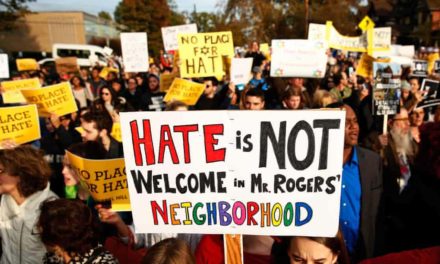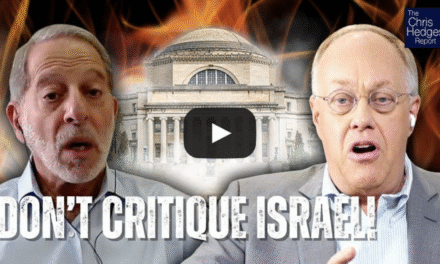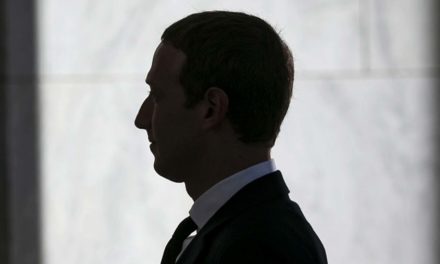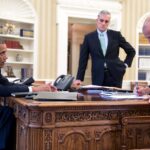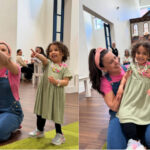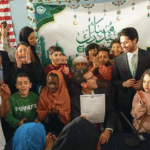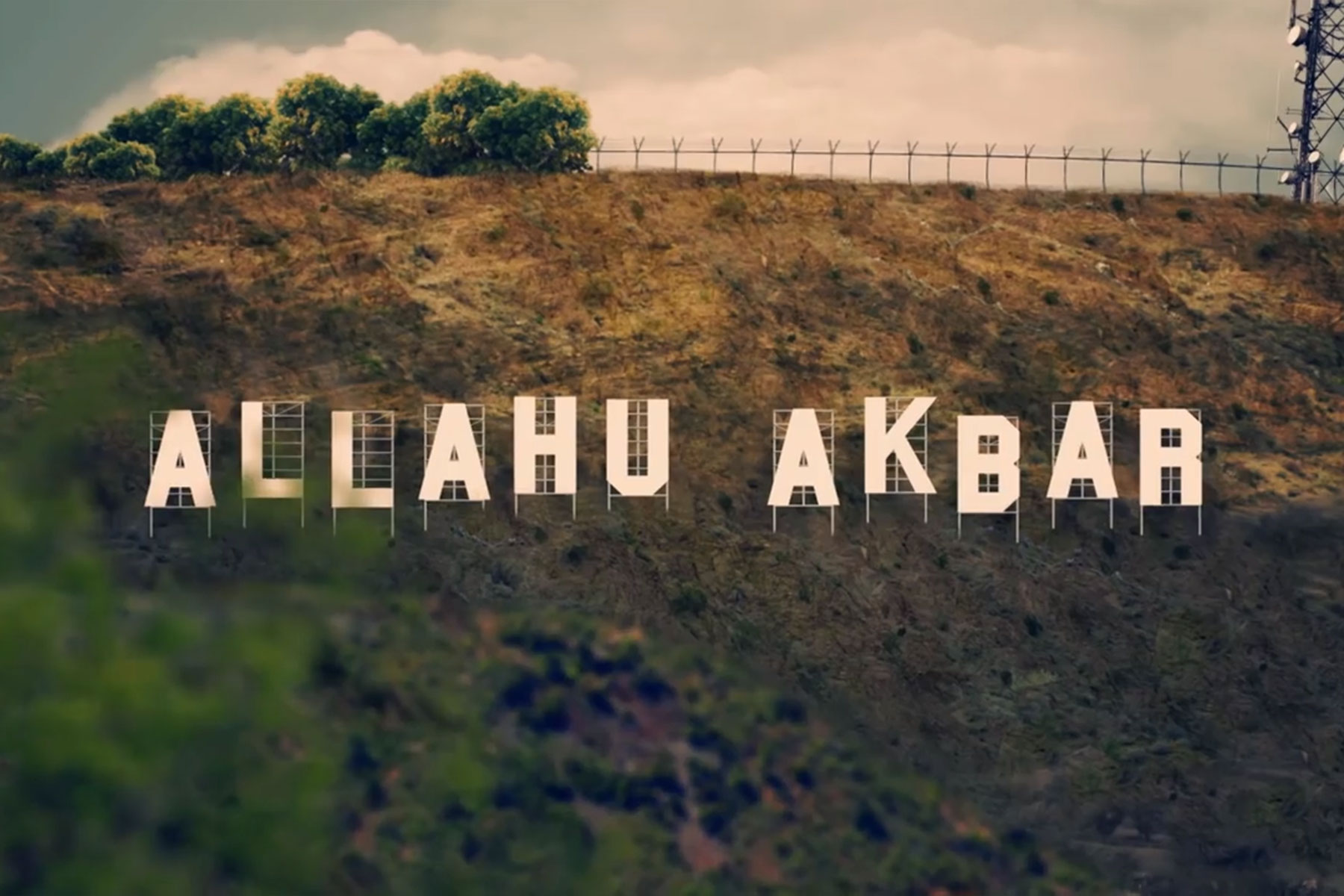
As the final weeks of the 2016 elections ticked down, voters in swing states like Nevada and North Carolina began seeing eerie promotional travel ads as they scrolled through their Facebook feeds or clicked through Google sites.
In one, a woman with a French accent cheerfully welcomes visitors to the “Islamic State of France,” where “under Sharia law, you can enjoy everything the Islamic State of France has to offer, as long as you follow the rules.”
The video has a “Man in the High Tower” feel. Iconic French tourist sites are both familiar and transformed — the Eiffel Tower is capped with a star and crescent and the spires of the Notre Dame are replaced with the domed qubba of a mosque.
The Mona Lisa is shown looking, the ad says, “as a woman should,” covered in a burka.
If it was not already clear that the ad was meant to stoke viewers fears of imminent Muslim conquest, the video is interspersed with violent imagery. Three missiles are seen flying through the sky as the video opens. Blindfolded men are shown kneeling with guns pointed at their heads, and children are shown training with weapons “to defend the caliphate.”
Another, for the “Islamic State of Germany,” invited visitors to “celebrate the arranged marriages of future jihadi soldiers” at a pork-free and alcohol-free Oktoberfest.
“You can even sell your daughter or sister to be married,” the ad notes enthusiastically while showing the covered face of a woman wearing a black burka.
And just to bring it all home, days before the election, the group made an “Islamic States of America“ travel promo, where Syrian refugees have overtaken America. In the ad, the iconic Hollywood sign reads “Allahu Akbar,” and the Statue of Liberty wears a burka and holds a star and crescent. In the video, Ground Zero in New York City is shown as place where citizens can “celebrate our Islamic victories.”
Most Americans have never heard of the far-right neoconservative nonprofit that ran the ads. It has no employees and no volunteers, and it is run out of the offices of a Washington DC law firm. More importantly, most voters never saw the ads.
And that was by design.
The group, a social welfare organization called Secure America Now, worked hand in hand with Facebook and Google to target their message at voters in swing states who were most likely to be receptive to them.
And newly obtained tax documents show that the money fueling the group came mostly from just three donors, including the secretive multimillionaire donor Robert Mercer.
As a 501(c)(4) social welfare organization, Secure America Now (SAN) is not required to disclose its donors to the public, but they are required to report them to the IRS. This information is usually redacted when provided for public inspection. However, when a request was made for a 2016 return, an unredacted return was provided by the group’s accounting firm.
The filing shows the largest individual contribution, $2 million, came from Robert Mercer, the reclusive hedge fund investor who spent millions in 2016 helping Donald Trump capture the White House.
Mercer has become a household name not only for his political spending in recent years or his peculiar interests, such as part-timing as a New Mexico police officer or funding stockpiles of urine in the Oregon mountains, but also for bankrolling the alt-right and the data firm Cambridge Analytica, both of which helped Trump clutch victory in 2016.
It was reported last month that SAN received another $2 million from the 45Committee, another pro-Trump dark money group, which is itself partly funded by other dark money groups.
The dark money churn is real.
Ronald S. Lauder, the heir to the Estee Lauder fortune, gave $1.1 million. Lauder has long been a supporter of conservative and pro-Israel causes, and his longtime political adviser Allen Roth serves as president of Secure America Now.
The remaining $60,000 in reported contributions came from three donors: Brad Anderson, the former CEO of Best Buy; Foster Friess, the investor and longtime Republican donor; and Olympus Ventures LLC, which is tied to a foundation created by Dick Schulze, the founder of Best Buy.
Social welfare organizations like Secure America Now are not supposed to have politics as their primary purpose, but a combination of vague rules and ineffective oversight make it easy for such groups to spend heavily in elections, without being required to disclose their donors.
SAN reported more than $1 million in political spending to the Federal Election Commission in 2016 — in the form of “independent expenditures,” which means they appealed directly to voters, asking them to support or oppose specific candidates for office.
While there are some differences between what the FEC and the IRS consider political spending, such direct calls for voters to support or oppose candidates are generally considered to be unambiguously political. Yet, in filing their tax returns, SAN told the IRS it only spent $124,192 on politics.
It is hard to discern where this discrepancy stems from. Marc Owens, a tax lawyer who used to head the IRS Exempt Organizations Division, pointed out that the “IRS ‘facts and circumstances’ standard has always been considered to sweep in more activity and expenditures than the FEC ‘independent expenditure’ standard.”
Yet, the IRS is not likely to catch the discrepancy on its own. The agency does not systematically analyze FEC reported political spending to catch discrepancies in what groups report on their tax returns. And only seven out of every 1,000 tax returns are audited by the agency, and even then the IRS is not always scrutinizing a group’s political activity.
Even with $1 million in political spending, SAN would find itself well below the threshold for excessive political activity — which, absent specific bright lines from the IRS, is generally assumed to be less than half of a group’s overall spending.
But the only way for the IRS to truly conclude that a group like SAN engaged in too much campaign intervention is to conduct a “facts and circumstances” analysis of the group’s finances. And that is why those parody travel promotions are so important.
The Islamic State ads offer an interesting test of areas where the IRS definition of campaign intervention might be more expansive than what election law defines as political, even though they don’t mention a candidate. As a Congressional Research Service report noted in 2012, “the standard for determining whether something is campaign activity under the IRC is whether it exhibits a preference for or against a candidate” — not, that is, whether the candidate is actually mentioned.
“Preference can be subtle,” the report notes, “and the IRS takes the position that it is not always necessary to expressly mention a candidate by name.”
The fact that SAN did not expressly mention candidates in its ads does not mean that they were not political. And facts that have been reported since the election suggest that there is plenty of evidence supporting the conclusion that SAN’s digital ads were aimed at influencing the election.
Internal reports from the ad agency that ran SAN’s digital campaign, and individuals who were involved with the effort, showed that SAN worked with Google and Facebook to target the ads at swing-state voters.
“Facebook advertising salespeople, creative advisers and technical experts competed with sales staff from Alphabet Inc.’s Google for millions in ad dollars from Secure America Now,” a report documented.
The ads were not targeted broadly at the American public, but at Americans who would be mostly likely to decide the winners in critical senate races and the campaign for the White House.
Other ads in the campaign highlight this aim. For example, other digital ads run by SAN targeted specific candidates. “STOP SUPPORT OF TERRORISM. VOTE AGAINST CATHERINE CORTEZ MASTO,” read one ad, referencing the Democratic candidate for Nevada’s open senate seat.
The ads “were viewed millions of times on Facebook and Google,” the report noted, citing internal documents. And Facebook went so far as to use Secure America Now as a test case for new technology, sending out 12 different versions of the video to see which was the most popular.
One other reason why the IRS might rule that the ads entail campaign intervention, despite being absent any mention of a candidate, is that the subject of Muslim’s entering the country was what Owens refers to as “an issue distinguishing the candidates for a given office.”
In December 2015, Donald Trump called for “a total and complete shutdown of Muslims entering the United States.” The month before, he had referred to Syrian refugees as possibly “one of the great Trojan horses.”
One of the most defining differences between Trump and his opponent was his views on Muslims in general, and Muslim refugees in particular. SAN’s ads were likely trying to exploit that difference when they targeted swing voters, with Google and Facebook’s help.
The tax filing itself offers little insight into how much these campaigns actually cost, beyond the “millions” cited by Bloomberg. Large portions of the group’s spending are a black hole. More than $7.4 million in the SAN’s spending — 87 percent of their overall outlays — went towards “membership educational development” and “direct mail educational program,” which aren’t defined or detailed anywhere in the filing.
Secure America Now representatives has not responded to any of the questions, other than to confirm receipt of the questions.
Neither the IRS nor the FEC are likely to look into SAN’s activities any time soon, if at all, so the group will continue to play a role in public life.
A recent news report detailing internal emails between top Trump fundraiser Elliott Broidy and a political adviser to leaders in the United Arab Emirates and Saudi Arabia noted that Broidy referenced SAN as “one of the groups I am working with” to push the Trump administration to fill key positions with individuals favorable to those Persian Gulf leaders.
Robert Maguire
Originally published on OpenSecrets.org as EXCLUSIVE: Robert Mercer backed a secretive group that worked with Facebook, Google to target anti-Muslim ads at swing voters

